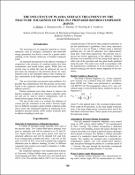Options
The Influence of Plasma Surface Treatment on the Fracture Toughness Peel Ply Prepared Bonded Composite Joints
Author(s)
Date Issued
2010
Date Available
2013-10-16T08:45:11Z
Abstract
The increasing use of composite materials in various
industries, such as aerospace, automotive and renewable
energy generation, has driven a need for a greater understanding
of the fracture behaviour of bonded composite
joints.
An important prerequisite for the adhesive bonding of
composites is the existence of a uniform surface free from
contaminants and mould release agents. While there are
several ways in which this may be achieved, the use of
peel plies has emerged as the preferred choice for many
industries due to the repeatable nature of the resulting surface,
particularly in the highly regulated aerospace industry.
The use of peel plies can present some problems. It is
possible that contamination from the peel ply can be transferred
to the composite substrate and adversely affect the
adhesive joint [1].
Plasma treatments have been shown to improve the
fracture toughness of adhesively bonded composite joints
[2] and can be used to remove contaminants, such as
mould release agents, from the surface [3].
The aim of this work is to evaluate the influence of
various peel ply treatments on the mode I fracture toughness
of different aerospace grade bonded composite joints
and to assess the subsequent benefits of employing an atmospheric
pressure plasma (APP) surface treatment prior
to adhesive bonding in each case.
industries, such as aerospace, automotive and renewable
energy generation, has driven a need for a greater understanding
of the fracture behaviour of bonded composite
joints.
An important prerequisite for the adhesive bonding of
composites is the existence of a uniform surface free from
contaminants and mould release agents. While there are
several ways in which this may be achieved, the use of
peel plies has emerged as the preferred choice for many
industries due to the repeatable nature of the resulting surface,
particularly in the highly regulated aerospace industry.
The use of peel plies can present some problems. It is
possible that contamination from the peel ply can be transferred
to the composite substrate and adversely affect the
adhesive joint [1].
Plasma treatments have been shown to improve the
fracture toughness of adhesively bonded composite joints
[2] and can be used to remove contaminants, such as
mould release agents, from the surface [3].
The aim of this work is to evaluate the influence of
various peel ply treatments on the mode I fracture toughness
of different aerospace grade bonded composite joints
and to assess the subsequent benefits of employing an atmospheric
pressure plasma (APP) surface treatment prior
to adhesive bonding in each case.
Type of Material
Conference Publication
Publisher
Adhesion Society
Copyright (Published Version)
2010 the authors
Language
English
Status of Item
Peer reviewed
Conference Details
33rd Annual Meeting of the Adhesion Society, Daytona Beach, Florida, 21 Feb 2010 - 24 Feb 2010
This item is made available under a Creative Commons License
File(s)
Loading...
Name
044.pdf
Size
264.58 KB
Format
Adobe PDF
Checksum (MD5)
36e460c7d5cb7f1f5eb5116677c067ca
Owning collection